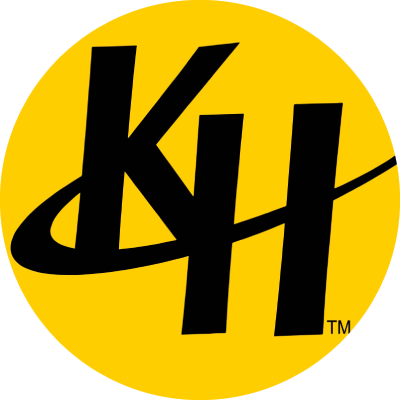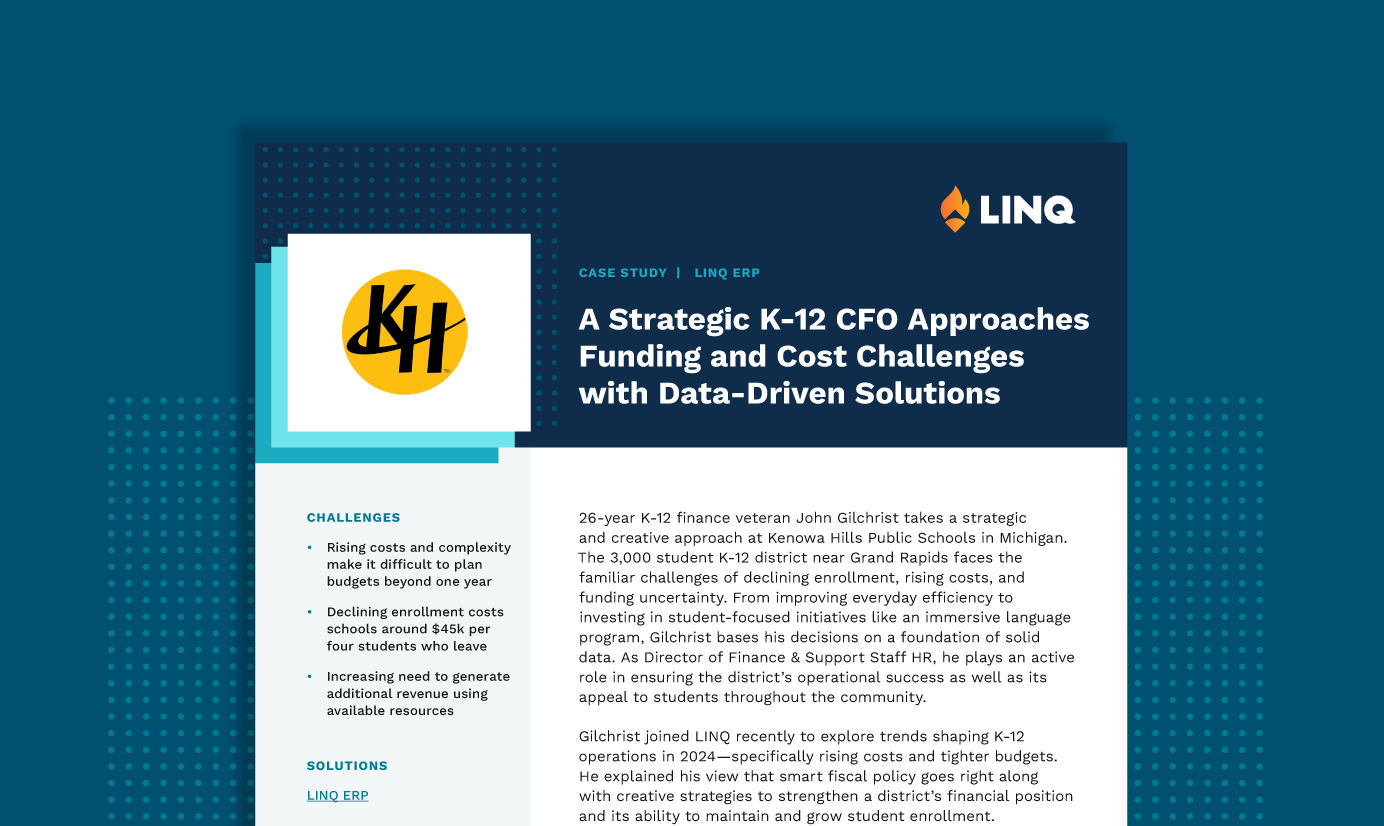Skip to Section:

“I use my LINQ data to estimate and run scenarios… I run my scenarios on expenses to know what I can afford today and into the next two or more years.”
John Gilchrist
Director of Finance & Support Staff HR
26-year K-12 finance veteran John Gilchrist takes a strategic and creative approach at Kenowa Hills Public Schools in Michigan. The 3,000 student K-12 district near Grand Rapids faces the familiar challenges of declining enrollment, rising costs, and funding uncertainty. From improving everyday efficiency to investing in student-focused initiatives like an immersive language program, Gilchrist bases his decisions on a foundation of solid data. As Director of Finance & Support Staff HR, he plays an active role in ensuring the district’s operational success as well as its appeal to students throughout the community.
Gilchrist joined LINQ recently to explore trends shaping K-12 operations in 2024—specifically rising costs and tighter budgets. He explained his view that smart fiscal policy goes right along with creative strategies to strengthen a district’s financial position and its ability to maintain and grow student enrollment.
Accurately forecasting a two-year budget plan proves essential
Longer-term budget planning gives districts freedom and security, according to Gilchrist. Accurate, real-time data and the right forecasting tools prove vital amid ongoing change in both education and the broader economy. “Thinking about a two-year budget instead of just one year at a time makes all the difference,” he says. LINQ ERP gives Kenowa Hills the information they need to plan further ahead, maximize their resources, and predict fluctuations in funding, enrollment, and costs.
Michigan offers districts a dynamic budget projection tool, and Gilchrist tells us he can make the most of it because LINQ ERP puts the data he needs right at his fingertips. “I use my LINQ data to estimate and run scenarios,” he says. “I know what my enrollment projections look like, I can estimate my revenues, and then I run my scenarios on expenses to know what I can afford today and into the next two or more years.” He tells us that visibility is crucial because contracts and commitments must be considered on a multi-year basis.
Thinking outside of the box to invest wisely and creatively
Declining enrollment impacts funding in many districts. Hanover Research recently cited that schools lose $45,568 for every four students who leave a district. Gilchrist says in Michigan, he sees multiple factors leading to fewer students entering public schools. “Part of it is a lower birthrate,” he explains, “and it’s also the push and pull effect of our Schools of Choice program.” Families can choose to enroll students in any school in the district, but the district is also competing against the choice to send students to private or charter schools in the area.
Gilchrist remembers how another district where he worked drove enrollment by providing a unique opportunity. They invested in a Chinese language immersion program for elementary students using American Recovery and Reinvestment Act (ARRA) funds in 2009. It was a big commitment, but it paid off by bolstering enrollment and is now offered across grades K-12 in that district.
“That program stabilized our enrollment. It’s one of my proudest career moments,” remembers Gilchrist. He says families chose to enroll their students in the district to take advantage of the one-of-a-kind experience. “It can be easy to say no to big initiatives, especially when facing limited resources, but you can often find new ways to invest and set your district on a new path instead of remaining in reactionary mode,” he reflects.
Gilchrist says declining enrollment calls for districts to market themselves. “Districts need to toot their own horn,” he says. From athletics to specialized academic programs and hands-on learning opportunities, schools can effectively “sell” their unique offerings. “Sometimes we’re so focused on surviving that we as districts forget to highlight the really positive and inspiring things that we do,” he says. His district focuses on their most successful and popular programs, evaluating them on metrics like participation and academic impact, and actively works with a public relations firm to ensure the community knows about them. He sees the results of their investment in marketing through detailed, trackable data in the district’s enrollment and student participation in programs.
Of course, accurate data and budget forecasts are key to confidently making the right investments. Gilchrist says that’s what enables him to launch an initiative, gauge its performance, then decide whether to continue it, adjust, or go a different direction.
Quadrupling school breakfast participation to tap into hidden revenue potential
Analyzing data can reveal potential revenue sources hiding just under the surface. Gilchrist says that Kenowa Hills recently noticed that very few students at secondary schools ate school breakfast. “Out of around 1,000 students, we typically had just 70 students eating breakfast,” he says.
Considering their options, the district determined that the morning rush was a likely barrier. “We just found that high school students aren’t ready to eat as soon as they show up,” Gilchrist explains. They introduced second-chance breakfast. After the first hour of the day, students get another opportunity to order and enjoy breakfast.
The numbers weren’t hard to decipher. “Our participation rates quadrupled,” he says. They went from 70 to around 300 students eating breakfast in their high schools every day. “All we had to do was buy some breakfast carts and make sure they’re staffed, but our nutrition program can easily sustain that,” he explains. It was a relatively minimal investment, but it yielded huge returns.
It all comes down to a single source of truth to drive decisions and gauge success
Informed decisions matter more now than ever. Limited resources, future challenges, and ever-present uncertainty can make survival the focus. However, Gilchrist saysa strategic CFO can profoundly impact district success and create more positive student experiences. The trick is having the right information, tools to analyze the data, and a mindset to embrace change and adjust when necessary.
With a single source of truth—real-time LINQ ERP data—Gilchrist and every other decision maker at Kenowa Hills can stay on the same page. Whether it’s a cost-saving purchasing decision, a revenue-generating activity, or a major educational initiative, they can confidently assess what they can afford, metrics of success, and a timeline for sustainability.
